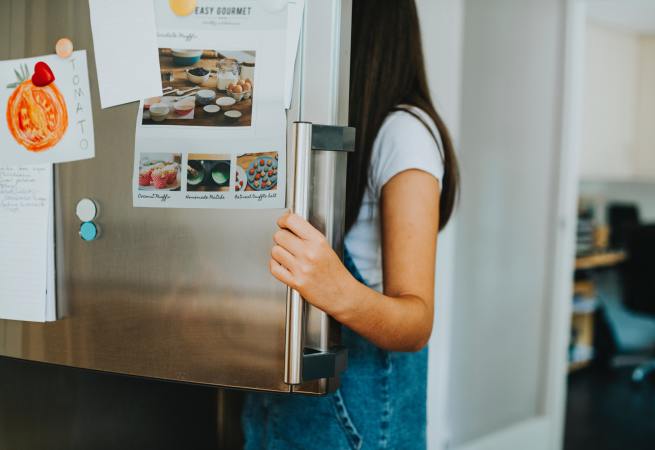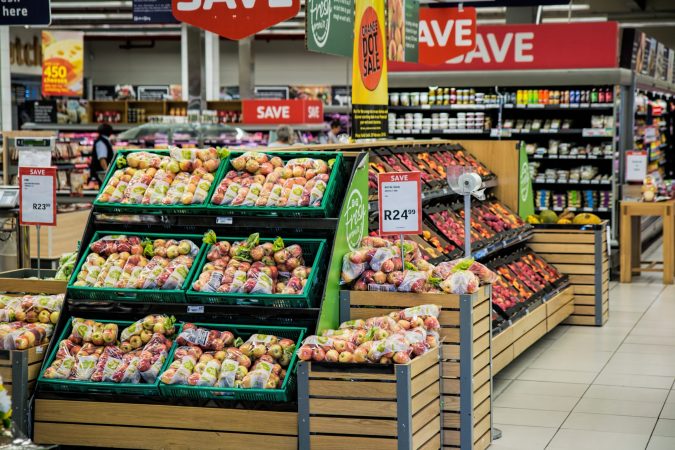

Follow all of PopSci’s COVID-19 coverage here, including the truth about herd immunity, advice for pregnant women, and a tutorial on making your own mask.
From production, to packaging, to shipping, to stocking, the stuff you buy at the store passes through many hands before it goes home with you. That might seem risky from a COVID-19 standpoint, but months into the pandemic, it seems that groceries and deliveries are low-risk vectors. Per the Food and Drug Administration’s website: “The virus is thought to spread mainly from person to person. Foodborne exposure to this virus is not known to be a route of transmission.”
Some studies have posited that certain supply chains may be susceptible to spreading in the virus. But so far most experts in the US agree that you’re more likely to be exposed from interacting with others at the grocery store than you are from a jar of salsa. But that doesn’t mean shoppers shouldn’t take a few extra minutes to implement some precautions, especially now that cases are cresting in most parts of the country.
Here’s a step-by-step guide to minimizing your risk of COVID-19 exposure from food and other purchased products:
Before you leave for the grocery store:
1. The first thing you can do to improve your health outcome is to avoid going inside the store at all. Search around for delivery services or farmers markets, or contact your local shops to see if they’re offering curbside pickup. If those options aren’t available, make a game plan that spaces your trips out every two weeks or more. (Some places are offering special visiting hours for elderly and immunocompromised people, so that might help in scheduling as well.) Take the time to plan your meals, free up room in your freezer, and cultivate a list of recipes that rely on staples that last a long time, like beans and pasta. Oh, and if grocery day rolls around and you or another member of your household are feeling sick, go on a day when everyone’s feeling better.
2. Designate a home sanitation station. That could be your garage, your porch, your apartment hallway, or your kitchen counter. Decide where you will put things that have not been treated and where you will put things that have been sanitized. If you’d like, use painter’s tape to mark off these zones to avoid cross-contamination. Wipe down your cleaning area with disinfectant and a clean rag or homemade wipes.
If you live in an apartment complex, it’s hard to ensure a spot in the hallway will be clean or remain so. Instead, simply prop open your door and designate everything in the hallway as “untreated.” Everything just over the threshold into your apartment is your “sanitized” zone. If your entryway area is carpeted or you just don’t trust yourself not contaminate it with your shoes, push table over to the door to be your clean area.
3. Put several clean rags (or a roll of paper towels) and a spray cleaner like Lysol in your sanitation station.
4. Many retail locations aren’t allowing reusable bags right now, so check for that. If you can bring your own bags to the store, use reusable ones that have been washed with soap and hot water. If you don’t have reusable bags that you can throw in the washing machine, opt for the plastic or paper bags at the store.
5. Wear a mask and bring a back-up one, too—it’s one of the best ways you can protect yourself and others outside of your home. If you’re donning a cloth mask, make sure it’s been cleaned since you last used it. You can also pack disposable or cloth gloves to put on once you start shopping.
6. Bundle up or bring otherwise appropriate weather gear. Certain states have indoor capacity limits, so you may have to wait in line to get into the store, especially in peak hours.
At the grocery store:
7. Lather your hands with sanitizer before heading into the store. You can make your own in bulk with just a few ingredients, so remember to stock up on supplies during your shopping run.
8. Disinfect your cart or basket. You should be able to find a wipe dispenser near the entrance—if not, just ask an employee if they can provide one.
9. Make sure to keep 6 to 10 feet between you and anyone from outside your own household. If somebody’s standing by a place you need to be, you can kindly request that they make room, or just go get something else on your list and try again in a few minutes.
10. Keep your mask on if you sneeze or have to cough. It might feel gross, but it’s the most practical way to keep your germs in check.
11. Avoid tasting samples (they shouldn’t be out anyway), using vending machines, and wetting your fingers to pull apart plastic produce bags. Try to only grab objects that you plan on taking with you.
12. Don’t touch your face. Touching contaminated surfaces and then your eyes or mouth is a common way to contract viruses. The same is true in reverse—touching your face before picking up items in the store means you could be shedding infectious particles that others will then take home.
13. Opt for contactless payment options, like a chip card or phone app, if possible. Cash is fine, too—coins and bills haven’t been pinpointed as a major point of contamination. More stores are experimenting with self-checkout lines: They help reduce human-to-human interaction, which is good, but also require you to touch more buttons. If you can, wipe down screens and keypads before and after you use them.
14. Take off your gloves if you were wearing them (disposable ones should go straight in the trash) and sanitize your hands and forearms before re-entering your car.
Back at home:
15. Drop your bags in your un-sanitized area, take your shoes off, and go wash your hands with soap for 20 seconds. You can sing a little song to mark the time if you want.
16. If your sanitation station is on the floor, be mindful of your feet. Don’t put dirty shoes in your clean area.
17. Studies have shown that the virus only survives on cardboard, steel, and plastic for a few hours, so the amount of rigor you put into this step is up to you. Start with packaged items, specifically the ones that can be easily unwrapped or decanted. If you got a big box of mini bags of pretzels, for example, take the mini bags out of the box and place them in your clean area. For other objects, simply wipe them down with cleaner and a cloth—you can spray sealed or wrapped items directly. Don’t use disinfectants like bleach and ammonia on groceries.. Discard the outer packaging, and make sure to wash your hands with for 20 seconds before refrigerating and putting everything away. Disposable gloves can come in handy here to keep things clean between steps.
18. Now let’s move on to produce. You shouldn’t wash fresh ingredients with soap—it’s not meant to be eaten and could irritate your stomach or intestines, making you feel nauseous and/or giving you diarrhea. Instead, just follow the FDA guidelines for cleaning produce. Wash your items thoroughly with cool water. Use a vegetable brush if you’d like, but make sure it’s clean. Dry all of your items with a paper towel (microbes love moisture). In general, viruses don’t live long on porous surfaces like plants, so you’re more likely to get sick from eating an apple with dirty hands than one that someone sick touched several hours ago.
That’s it! Enjoy your haul.























